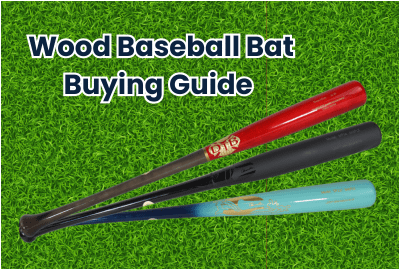There is no better sound in baseball than the crack of a wood bat. Since the very beginning, wood baseball bats have changed and evolved drastically over the last 100 years. In today’s game, professional players have a plethora of options to choose from when picking their perfect wood bat. With so many different styles, wood types, and cuts, choosing the right bat for your swing and style of play can be overwhelming. What’s the best baseball wood bat type, Maple, Birch or Ash? What wood bat knob style should I swing? Should my bat have a deep, medium or no cup? We want to make that process easier for you by explaining in length the different types of wood, turning models and options that are out there for you the buyer and player. Hopefully with this extensive and informative breakdown, you will find the best wood bat that will launch your game to the next level.

Wood Bat Materials
What the Difference Between Maple, Brich, and Ash Baseball Bats?
Maple baseball bats are much more dense when compared to that of birch or ash bats. The denser wood structure allows these bats to hold up a little longer than other wood types. The tight grain on maple bats will allow these to have a stiffer feel and thus have a higher performance rating. Currently maple bats are the most used wood type in professional baseball.
- Most dense wood makeup
- Tight grain pattern
- Stiff or little flex
- Very durable
- Most popular wood material for professional players
Maple Bat Options: Chandler AJ99, Chandler AB16, Marucci Bringer of Rain, Old Hickory MT27
Birch baseball bats are slightly less dense than maple but offer a slight flex. Players looking to make the jump from metal bats, will have a much better success in transition as birch bats will perform similar to BBCOR bats. Yellow birch is the most common birch type being used in the pros today. Players like Tim Anderson, and Pete Alonso have had tremendous success swinging birch bats in recent years.
- Dense wood
- Most durable wood option
- Slight flex
- Tight grain pattern
- Great option for players transitioning from metal bats
Birch Bat Options: Dove Tail PA20, Victus TA7, Dove Tail I13
For many years Ash bats used to be the main staple for major league hitters. With advancements in quality control and wood selection, maple and birch have become the more popular option for elite hitters. Ash bats are usually a little lighter and have a higher flex rating, when compared to maple or birch. Ash bats are less dense but are a more economical option for youth players looking for an inexpensive practice or summer tournament bat.
- Less dense
- Lightest wood option
- Less durable than maple or birch
- Wide grain pattern
- Mid flex rating


Wood Bat Cuts and Turning Models
For the longest time, there were specific industry standards for cuts and turns for wood bat models. As manufacturers grew and player preferences changed and evolved, these cuts have been altered to fit specific pro players' wants and needs. These wood cuts have now mostly evolved into pro player models . Let’s take a look at the main industry standards for wood bat cuts. Keep in mind player models like the AP5 and the RA13 are hybrids of these and these styles and can vary slightly based on manufacturer and wood type. These standard cuts are the most popular styles but there are many more cuts availble.

Barrel Diameter: 2.5 inches Taper: Long Handle Thickness: 1 inch
The 110 cut is the most balanced of these standard models. Players looking to maximize bat control and swing velocity tend to prefer bats in this variety. Hitters looking to segway from a metal BBCOR or -5 bat, should consider wood bats that are more balanced in swing weight like the 110 style.
Similar Bat Options: Slugger BPAS

Barrel Diameter: 2.5 inches Taper: Long Handle Thickness: 15/16 inch
One of the most popular wood bat cuts still to this day is the 271. A similar cut to the 110, however the 271 has a quicker handle to barrel taper. This slightly endloaded feel is a great option for both contact and power oriented players, making this one of the most sought after options for both youth and pro players alike.
Similar Bat Options: Old Hickory 28NA Steel Pressed, Old Hickory 28NA, Chandler CB271, Victus JC24

Barrel Diameter: 2.5 inches Taper: Medium Handle Thickness: 15/16 inch
The I-13 cut is specifically designed for power hitters as the taper between the handle and barrel is very quick. A larger barrel with a bigger sweet spot is the result. Elite power hitters who like a bigger barrel with an endloaded feel will prefer this cut over the 271 and the 110.
Similar Bat Options: Louisville Slugger RA13, Chandler RA13, Dove Tail I13, Chandler CC13, Victus TA7

Barrel Diameter: 2 9/16 inches Taper: Medium Handle Thickness: 15/16 inch
The 243 cut is the most endloaded of all the standard cuts and models. A massive barrel with a thin handle. A lot of power hitting pros prefer this style as the payoff for a perfectly squared up pitch is huge. The 243 model is one of the hardest to control and swing, and is usually only recommended for stronger hitters.
Similar Bat Options: Louisville Slugger CB35, Chandler KB17, Old Hickory J143
Still having trouble finding the right bat, or have any questions about wood bats? Please contact us 1-800-997-4233 or [email protected]. Our wood bat experts can answer any questions you might have in regards to youth or adult wood baseball bats.
For an extensive list of popular player models check out our list here

